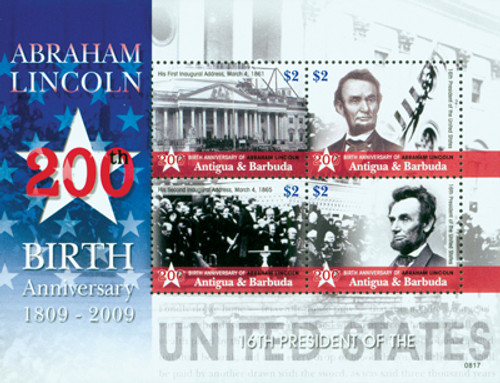
2011 Antigua U.S. Civil War 4v Mint
# M10961 - 2011 Antigua U.S. Civil War 4v Mint
$10.95
Civil War 150th Anniversary
This mint stamp sheet from Antigua pictures President Abraham Lincoln and commemorates the 150th anniversary of the Civil War.
Less than two months after Lincoln’s address, the Confederates fired on Union troops at Fort Sumter, on April 12, 1861, officially beginning the Civil War. Lincoln then called upon 75,000 troops to recapture forts, protect Washington, D.C., and “preserve the Union.” This forced the states to choose sides, leading North Carolina, Tennessee, Arkansas, and Virginia to secede, with Richmond, Virginia, becoming the new Confederate capital.
Lincoln faced criticism from all sides, with war opponents unhappy that he would not compromise on the slavery issue and Radical Republicans believing he was taking too long to abolish slavery. His primary goals were to protect the capital and win the war as quickly as possible – some newspapers expected the war to end in just 90 days.
Following the Union victory at the Battle of Antietam in September 1862, Lincoln issued his Emancipation Proclamation, which he had written months earlier. The proclamation, which went into effect the following January, freed all slaves in the Confederate States of America and permitted African Americans to join the Union Army.
Four years of fighting reached an end on April 9, 1865, when Confederate General Robert E. Lee surrendered to Grant at the Appomattox Court House in Virginia. With the war over, Lincoln finally felt relief and was prepared to lead the United States through Reconstruction.
But on April 14, 1865, while attending the play Our American Cousin at Ford’s Theater, well-known actor and Confederate spy John Wilkes Booth snuck up behind the unprotected President and shot him in the head. Lincoln was taken to the Petersen House across the street, where he remained in a coma for nine hours. He was the first U.S. President ever to be assassinated.
Civil War 150th Anniversary
This mint stamp sheet from Antigua pictures President Abraham Lincoln and commemorates the 150th anniversary of the Civil War.
Less than two months after Lincoln’s address, the Confederates fired on Union troops at Fort Sumter, on April 12, 1861, officially beginning the Civil War. Lincoln then called upon 75,000 troops to recapture forts, protect Washington, D.C., and “preserve the Union.” This forced the states to choose sides, leading North Carolina, Tennessee, Arkansas, and Virginia to secede, with Richmond, Virginia, becoming the new Confederate capital.
Lincoln faced criticism from all sides, with war opponents unhappy that he would not compromise on the slavery issue and Radical Republicans believing he was taking too long to abolish slavery. His primary goals were to protect the capital and win the war as quickly as possible – some newspapers expected the war to end in just 90 days.
Following the Union victory at the Battle of Antietam in September 1862, Lincoln issued his Emancipation Proclamation, which he had written months earlier. The proclamation, which went into effect the following January, freed all slaves in the Confederate States of America and permitted African Americans to join the Union Army.
Four years of fighting reached an end on April 9, 1865, when Confederate General Robert E. Lee surrendered to Grant at the Appomattox Court House in Virginia. With the war over, Lincoln finally felt relief and was prepared to lead the United States through Reconstruction.
But on April 14, 1865, while attending the play Our American Cousin at Ford’s Theater, well-known actor and Confederate spy John Wilkes Booth snuck up behind the unprotected President and shot him in the head. Lincoln was taken to the Petersen House across the street, where he remained in a coma for nine hours. He was the first U.S. President ever to be assassinated.











